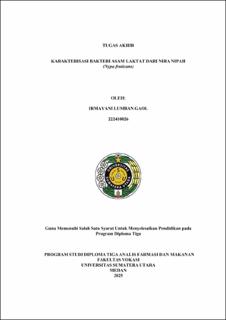| dc.description.abstract | Background: Lactic acid bacteria are a group of gram-positive bacteria in the form
of cocci or bacilli. These bacteria are facultative anaerobes, catalase-negative,
motile, non-spore-forming, and produce lactic acid as a metabolic end product
during carbohydrate fermentation. Lactic acid bacteria (LAB) play an important
role in improving performance and mitigating disease due to their ability to maintain
the physiological balance of the gastrointestinal tract and their resistance to
pathogenic bacteria. Lactic acid bacteria are classified as homofermentative or
heterofermentative based on their metabolic pathways.
Objective: The purpose of this study was to determine the effect of fermentation
time on the characteristics of lactic acid bacteria isolated from fermented nipah
palm sap (Nypa fruticans).
Methods: The method used in this study was to identify and characterize lactic acid
bacteria by conducting a series of biochemical tests such as the catalase test, triple
sugar iron agar (TSIA) test, fermentation, sulfur indole motility (SIM), and
Simmons citrate test.
Results: The study showed that 12 bacterial colonies were successfully isolated
from the fermented nipah sap. Based on biochemical tests, the catalase test was
negative, the triple sugar iron (TSI) test for 6 acid/acid (A/A), 5 alkali/alkali (K/K),
and 1 alkali/acid (K/A) isolates showed homofermentation, the Sulfur Indole
Motility (SIM) test was negative, and 7 isolates had a Simmons citrate test with 5
positive isolates.
Conclusion: There were 12 lactic acid bacteria isolates from the fermented nipah
sap that showed negative catalase characteristics, homofermentation type of
fermentation, did not produce sulfide and indole, and had variations in sugar
fermentation ability on TSIA media and citrate utilization. | en_US |


